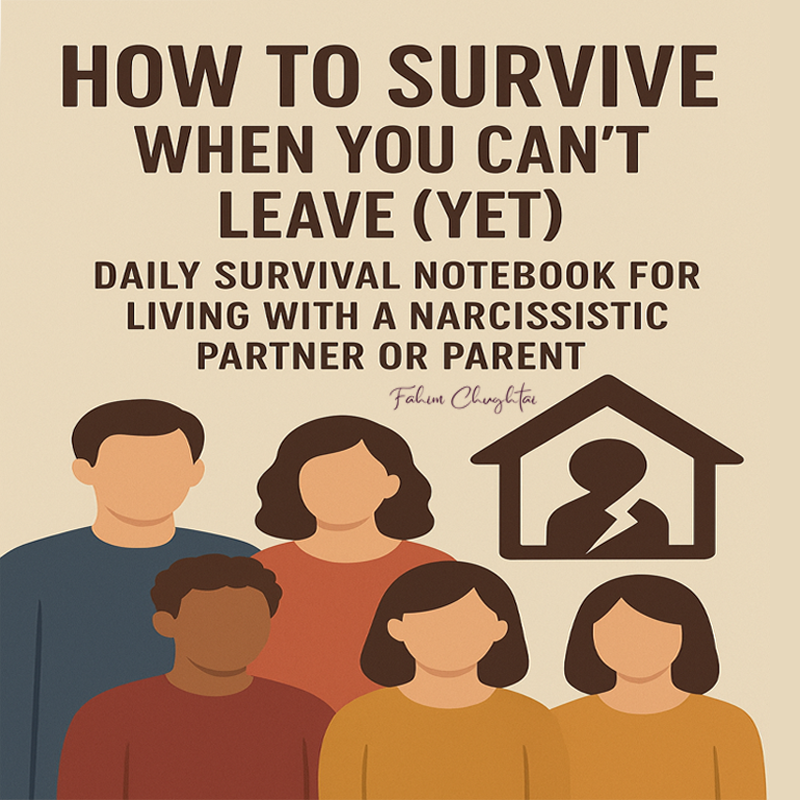You're sitting at your desk, stomach in knots, staring at yet another passive-aggressive message from them. Something about it feels… off. The words seem kind enough on the surface, but underneath, they leave you feeling guilty, confused, and questioning your own judgment. If this sounds familiar, you might be dealing with a covert narcissist.
- The Covert Face of Narcisssim
- Why Traditional Boundaries Don’t Work with Covert Narcissists
- Your Boundary-Setting Blueprint: The Science of Setting Healthy Boundaries That Actually Stick
- Surviving the Pushback
- Communication Strategies that Work: Mastering Conversations with a Covert Narcissist
- The Perfect Timing: When to Deploy Your Communication Strategies
- The Path Forward: Your Journey to Emotional Freedom
Learning how to set boundaries with a covert narcissist isn't just helpful – it's essential for your survival. Unlike their more obvious counterparts who demand attention with grand gestures and obvious manipulation, covert narcissists work in the shadows. They're masters of subtle emotional manipulation, using quiet guilt trips, gentle gaslighting, and kernel-sized doses of shame that build up over time until you can barely recognize yourself.
But here's what most advice gets wrong: traditional boundary-setting techniques often backfire with covert narcissists. Why? Because their weapons aren't shouts and demands – they're whispers and implications. And in the next few minutes, you'll discover exactly how to protect yourself without triggering their most manipulative behaviors.
You're about to learn:
Am I Dealing With a Covert Narcissist — or Just Toxic Behavior?
- Why your previous attempts at setting boundaries might have made things worse
- The counterintuitive first step that actually makes boundaries stick
- A revolutionary communication approach that cuts through their manipulation
- Exactly how to maintain your boundaries even when they push back (and they will)
- The crucial self-protection strategies most experts never talk about
Whether it's a family member, romantic partner, or colleague, you're about to discover how to reclaim your emotional freedom while dealing with a covert narcissist. Ready to take back control? Let's begin with the most important thing you need to understand about covert narcissism…
The Covert Face of Narcisssim
Picture walking through a garden filled with roses. Some have obvious thorns that you instantly notice and avoid. But others – the most dangerous ones – have hidden their thorns beneath a velvet-soft appearance. These are your covert narcissists, and learning how to set boundaries with a covert narcissist starts with understanding their subtle yet devastating nature.
You might be wondering why some narcissists operate in the shadows while others crave the spotlight. The answer lies in their emotional evolution. While overt narcissists developed a survival strategy of dominating through grandiosity, covert narcissists learned that playing the victim, appearing humble, and manipulating from behind the scenes brought them the control they craved.
Think of covert narcissism as emotional quicksand. By the time you realize you're sinking, you're already in deep. These master manipulators display their narcissism through subtle signs that often masquerade as sensitivity or conscientiousness. They're the colleague who seems so humble yet somehow always makes you feel inadequate. The friend who appears to care deeply about your problems while subtly undermining your achievements. The partner whose “concern” for your wellbeing actually controls your every move.
Let's explore the telltale signs of a covert narcissist that most people miss:
The Quiet Control Artist: They don't demand attention – they steal it through subtle manipulation. You'll find yourself constantly explaining your decisions, even when you shouldn't have to. It's like being cross-examined by the gentlest prosecutor you've ever met.
The Professional Victim: While typical narcissists boast about their superiority, covert narcissists weaponize their suffering. They've mastered the art of using their “pain” to control others. Every conversation somehow circles back to their struggles, making your issues seem insignificant in comparison.
The Stealth Saboteur: Their support comes with invisible strings. They'll help you with a project, then subtly undermine your confidence. “I'm just worried you might not be ready for such a big responsibility,” they say, their words dripping with fake concern.
The Passive Guilt Master: Instead of direct demands, they use sighs, subtle expressions of disappointment, and gentle implications to make you feel guilty for not meeting their unspoken expectations. It's death by a thousand paper cuts to your self-esteem.
Here's what makes covert narcissists particularly dangerous: their tactics are so subtle that you often blame yourself for the relationship problems. You start questioning your own judgment, wondering if you're being “too sensitive” or “ungrateful” for their “support.” This self-doubt is exactly what they want – it's the fertile ground where their manipulation thrives.
But there's something even more crucial you need to understand about setting boundaries with these hidden manipulators. Something that explains why traditional advice about being direct and firm often backfires spectacularly…
Why Traditional Boundaries Don't Work with Covert Narcissists
You've probably read all the standard advice about setting boundaries: “Just be direct.” “Stand firm.” “Clearly state your needs.” And if you've tried these approaches with a covert narcissist, you've likely discovered a frustrating truth – these traditional methods not only fail but often make the situation worse.
Here's why: Covert narcissists operate in the shadows of plausible deniability. When you try to set direct boundaries, they don't respond with obvious resistance. Instead, they employ sophisticated narcissistic manipulation techniques that turn your boundary-setting attempts against you. It's like trying to catch smoke with your bare hands – the harder you grasp, the more it slips through your fingers.
Let's dive into what actually happens when you attempt traditional boundary setting with a covert narcissist. Imagine telling a covert narcissist directly that their behavior is unacceptable. Instead of open defiance, they might respond with, “I'm just trying to help. I guess I care too much.” Suddenly, you're the one feeling guilty, questioning whether you're being unreasonable. This is their mastery at work.
These hidden manipulators have developed an arsenal of sophisticated responses to boundaries. They've learned that playing the victim is far more effective than playing the tyrant. When you try to establish limits, they don't yell or demand – they wound with whispers. They employ what therapists call “manipulative martyrdom,” making their compliance with your boundaries seem like a painful sacrifice on their part.
Consider Sarah's story: When she tried setting boundaries with her covert narcissistic colleague by stating she wouldn't take on extra projects, he responded with subtle sighs and comments like, “I understand… it's just that the team really needs someone reliable right now.” The next day, other coworkers seemed distant, having heard through the grapevine how she was “letting the team down.” This is the covert narcissist's real power – they don't just resist your boundaries; they restructure reality to make you the villain for having them.
The manipulation techniques these hidden narcissists use are particularly insidious because they're designed to seem reasonable on the surface. They might:
- Express “concern” about your need for boundaries
- Frame your limits as signs of personal problems
- Use passive-aggressive compliance that makes you look unreasonable
- Create situations where enforcing your boundaries appears selfish
- Recruit others to pressure you through subtle triangulation
But here's what you really need to understand – the reason traditional boundaries fail isn't just about their manipulation techniques. It's about something deeper, something that explains why even the most confident people struggle to maintain boundaries with covert narcissists. And once you understand this crucial element, you'll see why a completely different approach is necessary…
Your Boundary-Setting Blueprint: The Science of Setting Healthy Boundaries That Actually Stick
Here's the counterintuitive truth about setting healthy boundaries with a covert narcissist: the first step isn't about what you say to them – it's about what you stop saying to yourself. Before you can build an effective external boundary, you need to dismantle the internal barriers they've helped construct in your mind.
Think of boundary setting like building a house. Most people jump straight to putting up walls (setting limits) without first laying a proper foundation (internal preparation). This is why their boundaries crumble at the first sign of guilt or manipulation. The secret lies in understanding that setting healthy boundaries with a covert narcissist requires a completely different blueprint than what you've been taught.
Let's break down this revolutionary approach step by step:
Phase 1: Internal Foundation Work
Remember how covert narcissists make you question your right to have boundaries? This is where we start. Before announcing any boundaries, spend two weeks documenting their subtle manipulation. Write down every guilt trip, every passive-aggressive comment, every time they make you feel small. This accomplishes two crucial things: it validates your experience and creates a concrete record you can reference when self-doubt creeps in.
Phase 2: The Boundary Framework
Now, here's where most advice gets it wrong. Instead of starting with big, sweeping boundaries, begin with what we call “micro-boundaries.” These are small, seemingly insignificant limits that let you practice boundary setting while flying under their manipulation radar. For example, instead of declaring “Stop manipulating me!” (which will trigger their defensive tactics), start with something like taking five minutes alone to think before responding to their requests.
Phase 3: The Implementation Strategy
This is where the magic happens. When setting boundaries with a covert narcissist, your delivery matters more than the actual boundary. Use what psychologists call the “empowered observation” technique. Instead of saying “You need to stop doing X,” try “I've noticed I feel better when I have time to consider decisions independently.” This approach makes it harder for them to paint you as the aggressor while maintaining your boundary.
The Revolutionary Three-Part Response Formula:
- Acknowledge their perspective (disarms their victim stance)
- State your position as a personal preference (harder to argue with)
- Provide an alternative that maintains your boundary
For example: “I understand you want an immediate answer (acknowledgment), but I've learned I make better decisions when I take time to think (personal preference). I'll let you know my decision by tomorrow afternoon (alternative).”
But here's what most people don't realize about setting boundaries with covert narcissists: the real test isn't setting the boundary – it's what happens next. Their response will likely trigger every self-doubt button they've installed in your psyche over the years. This is where most boundary-setting attempts fail, and it's exactly why you need to understand the crucial next phase of this process…
The blueprint I've outlined here isn't just theory – it's based on proven psychological principles about how covert narcissists operate and what actually works to maintain boundaries with them. But before we move on to handling their inevitable pushback, let me ask: which of these steps seems most challenging to you? Understanding your specific concerns will help me provide more targeted strategies in the next section.
Surviving the Pushback
When you first set a boundary with a covert narcissist, their initial reaction might seem surprisingly mild. They might nod, smile, or even appear to understand. But don't be fooled – this is just the calm before the storm. Understanding how to deal with narcissistic abuse means preparing for what comes after that first deceptive acceptance.
Think of a covert narcissist's response to boundaries like a slow-moving hurricane. The first wave might feel manageable, but it's followed by increasingly intense circles of manipulation. Let me walk you through what really happens and how to stay strong through each phase of their pushback.
The First Wave – The Guilt Offensive
In the days following your boundary setting, they'll launch what therapists call the “concern campaign.” You'll hear things like, “I'm worried about these changes in you,” or “You seem so distant lately.” They're not just expressing concern – they're laying the groundwork for making you question your own judgment. This is when most people start wavering, but here's your power move: recognize that their “concern” is actually confirmation that your boundaries are working.
The Second Wave – The Triangulation Trap
When direct guilt doesn't work, they'll begin recruiting others. Suddenly, mutual friends or colleagues start asking if you're “okay” or mentioning how “hurt” the narcissist seems. This isn't coincidence – it's a calculated strategy to make you feel isolated and unreasonable. Your defense? Document everything. Keep a detailed record of your interactions and the boundary violations that made them necessary. This isn't just for legal protection – it's your anchor when the gaslighting intensifies.
The Third Wave – The Crisis Creation
Here's where things get intense. When they realize their subtle tactics aren't working, they'll manufacture crises designed to make your boundaries seem cruel or impossible to maintain. They might create emergency situations that “require” you to break your own rules, or they'll have convenient breakdowns right before important events in your life. Understanding this pattern is crucial for dealing with narcissistic abuse – these crises aren't random; they're tactical.
Your Survival Blueprint:
- Maintain what therapists call “radical consistency.” Your boundaries aren't up for negotiation, no matter what emotional emergency they present.
- Create a support network of people who understand covert narcissism. You'll need these reality checks when the gaslighting intensifies.
- Practice emotional containment – their feelings about your boundaries are not your responsibility to manage.
But here's what most people dealing with narcissistic abuse don't realize: the intensity of their pushback is directly proportional to how effective your boundaries are. When they fight hardest against your limits, it's actually a sign that your boundaries are working exactly as they should.
The most crucial skill you'll need through all of this isn't strength – it's discernment. Learning to recognize the difference between genuine interaction and manipulation attempts becomes your superpower. This leads us to the next vital piece of the puzzle: developing a communication strategy that cuts through their tactics while protecting your emotional well-being…
The strategies I've outlined aren't just defensive measures – they're stepping stones to reclaiming your personal power. But before we move into communication techniques, I want to address what might be your biggest concern: How do you maintain these boundaries when it feels like the whole world is pushing against them? The answer lies in understanding a revolutionary communication approach that changes the entire dynamic…
Communication Strategies that Work: Mastering Conversations with a Covert Narcissist
Let me share something powerful with you: the phrase that can stop a covert narcissist's manipulation mid-track is deceptively simple – “I notice that…” These three words change everything because they shift the conversation from emotional manipulation to observable reality, where narcissist communication patterns lose their power.
Understanding the Psychology Behind the Strategy When you communicate with a covert narcissist, you're not just having a conversation – you're navigating an emotional minefield where words have hidden traps. They've mastered the art of using subtle linguistic patterns to maintain control. Think of their communication style as a chess game where they're always three moves ahead, except you've been playing checkers.
The Revolutionary “Notice” Technique Let's break down how this works in real situations. When you start a statement with “I notice that,” you accomplish three crucial things:
- You ground the conversation in observable reality
- You avoid triggering their defensive mechanisms
- You maintain your perspective without making accusations
Here's how to apply this in real situations:
Scenario 1: The Guilt Trip Covert Narcissist:
“I guess I'll just handle this project alone since no one else seems to care about my wellbeing…” Traditional Response: “That's not fair! I've been helping you all week!” Effective Response: “I notice that when I set work boundaries, the conversation turns to questioning my commitment. I'm clear about my contributions, and I'll maintain my scheduled hours.”
Scenario 2: The Silent Treatment
Covert narcissist gives prolonged silent treatment after you decline a request Traditional Response: “Why are you acting this way? This is childish!” Effective Response: “I notice that our communication patterns have changed since I declined your request. I'm happy to discuss this directly when you're ready to engage in open dialogue.”
Still Living With Them? You’re Not Helpless.

The Power of Pattern Interruption Here's what makes this approach so effective – it interrupts their established manipulation patterns. Covert narcissists expect you to either defend yourself or become emotional. When you instead calmly observe their behavior, you step outside their manipulation playbook. It's like changing the rules of the game while they're mid-move.
Advanced Communication Techniques:
- The Reality Mirror: Reflect their behavior back without judgment “I notice that every time I succeed, the conversation turns to your disappointments.”
- The Boundary Reinforcement Loop: Link observations to your boundaries “I notice these urgent requests often come after I've set a boundary. My boundary remains: I need 24 hours' notice for new projects.”
- The Pattern Highlight: Name the pattern without accusation “I notice this is the third time this week that my accomplishments have been followed by criticism.”
But here's what most people don't realize about communicating with covert narcissists: your tone and timing are just as important as your words. This leads us to the most crucial element of all – the delivery system that makes these strategies work…
You’ve Seen the Patterns. Now Break the Bond.
The Missing Piece: Strategic Timing. The effectiveness of these communication strategies multiplies when you understand the perfect timing for their deployment. Would you like to know the exact moments when these phrases have maximum impact, and why timing can make the difference between success and failure in maintaining your boundaries?
The Perfect Timing: When to Deploy Your Communication Strategies
The secret to effectively communicating with a covert narcissist isn't just about what you say – it's about when you say it. Let me share the three most powerful moments to deploy your “I notice” statements and boundary reinforcement.
The First Warning Sign
When you catch their first subtle shift – a slight change in tone, a small passive-aggressive comment, or a tiny guilt trip – this is your golden moment. Don't wait for full escalation. Jump in early with “I notice the tone has shifted” or “I notice this conversation is moving toward guilt.” Early intervention prevents their manipulation from gaining momentum.
The Pattern Recognition Point
As soon as you spot them starting a familiar manipulation cycle (like triangulating with others or starting their silent treatment), step in immediately. This disrupts their strategy before it fully develops. A simple “I notice this pattern emerging” can stop their typical tactics in their tracks.
The Calm Before the Storm
When they seem unusually agreeable after you've set a boundary, this apparent peace is actually your crucial moment to reinforce your position. Their agreeable facade often precedes their most sophisticated manipulation attempts. Use this time to clearly restate your boundary.
Remember: Like a martial artist choosing the perfect moment to redirect energy, your timing can make a good strategy great. The goal isn't to catch every manipulative attempt – it's to intervene at the moments that matter most for protecting your boundaries and mental health.
The Path Forward: Your Journey to Emotional Freedom
You've now discovered the hidden patterns of covert narcissism, learned why traditional boundaries fail, and mastered powerful communication strategies that actually work. But understanding these concepts is just the beginning – the real transformation happens when you put them into practice.
Think of your journey like building immunity: each time you successfully implement a boundary, your emotional resilience grows stronger. Every time you use the “I notice” technique effectively, your confidence in handling manipulation increases. These aren't just strategies – they're the building blocks of your emotional freedom.
By implementing these boundary-setting tools, you're not just protecting yourself; you're reclaiming your reality. Remember how confusing and draining interactions with the covert narcissist used to be? Armed with your new understanding and practical techniques, you can now:
- Navigate their subtle manipulation attempts with confidence
- Maintain your boundaries without guilt
- Protect your emotional energy
- Trust your perceptions when gaslighting occurs
- Build healthier relationships in all areas of your life
The changes you'll experience won't happen overnight, but each small victory strengthens your resolve. Every time you successfully maintain a boundary, you're not just winning that moment – you're rewiring your response to manipulation for all future interactions.
Ready to Take the Next Step?
Your journey toward emotional freedom doesn't have to be a solo endeavor. I've created two powerful resources to support your growth:
- The Boundary Setting Workbook: A practical guide that includes:
- Daily boundary-setting exercises
- Response templates for common manipulation scenarios
- Pattern recognition worksheets
- Progress tracking tools
- Self-care strategies
- Our Supportive Community: Connect with others who understand your journey:
- Weekly live Q&A sessions with mental health professionals
- Private discussion forums
- Resource sharing
- Success story celebrations
Click below to download your free Boundary Setting Workbook and join our community of survivors and thrivers. Remember, setting boundaries with a covert narcissist isn't just about protecting yourself – it's about reclaiming the life you deserve.
The tools for your transformation are ready. Are you?






